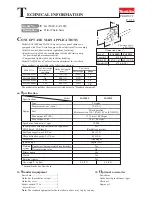
EN-6
- When the blade is pinched or bound tightly by the kerf closing
down, the blade stalls and the motor reaction drives the unit
rapidly back toward the operator;
- If the blade becomes twisted or misaligned in the cut, the teeth
at the back edge of the blade can dig into the top surface of the
wood causing the blade to climb out of the kerf and jump back
toward the operator.
Kickback is the result of saw misuse and/or incorrect operating
procedures or conditions and can be avoided by taking proper
precautions as given below.
a) Maintain a firm grip with both hands on the saw
and position your arms to resist kickback forces.
Position your body to either side of the blade, but
not in line with the blade.
Kickback could cause the saw
to jump backwards, but kickback forces can be controlled by
the operator, if proper precautions are taken.
b) When blade is binding, or when interrupting a cut
for any reason, release the trigger and hold the
saw motionless in the material until the blade
comes to a complete stop. Never attempt to
remove the saw from the work or pull the saw
backward while the blade is in motion or kickback
may occur.
Investigate and take corrective actions to
eliminate the cause of blade binding.
c) When restarting a saw in the workpiece, centre
the saw blade in the kerf and check that saw teeth
are not engaged into the material.
If saw blade is
binding, it may walk up or kickback from the workpiece as the
saw is restarted.
d) Support large panels to minimise the risk of blade
pinching and kickback.
Large panels tend to sag under
their own weight. Supports must be placed under the panel on
both sides, near the line of cut and near the edge of the panel.
e) Do not use dull or damaged blades.
Unsharpened or
improperly set blades produce narrow kerf causing excessive
friction, blade binding and kickback.
f) Blade depth and bevel adjusting locking levers
must be tight and secure before making cut.
If blade
adjustment shifts while cutting, it may cause binding and kickback.






































